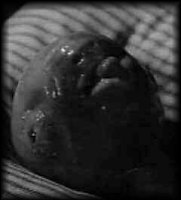
It's official. I am now a fully-fledged initiate into the world of the experimental art film. On Saturday, June 24th I viewed David Lynch's cult masterpiece
Eraserhead for the very first time.
The synopsis for this film that appears on Zip.ca (online DVD store to which Richard & I subscribe) reads as follows: "
Surreal, nightmarish psychological horror film set in neo-Gothic industrial wasteland. Art-house cult favorite is compulsory for fans of non-mainstream fare in mood for bizarre, disturbing film."
Yep, pretty much. The photography in this film is gorgeous; remarkable when you consider the shoestring budget on which the film was created. In his director's commentary, Lynch speaks at great length on the expert lighting techniques of his Director of Photography (whose name now escapes me). Sadly, this lighting wizard met an untimely early death, as did a couple of other crew members. Kinda makes ya wonder, huh?
I did enjoy this film very much. Strange, yes. It unravels before your eyes like Lynch's very private nightmare world. Like a true artist, Lynch sets up a complex vocabulary of symbols and then just lets them interact.
I never did see a "Lady in the Radiator". I did see the radiator glowing with this unearthly light, and something that resembled a soggy mass of hair piled at the base of said radiator. But a lady? Nope.
I felt a great pathos for the inconsolable cries of the monster baby. Poor little fetal-calf-looking creature, isolated as it was on the table across the room from the parental bed. No wonder it cried so much. (Perhaps this is just my maternal urgings talking, though.)


